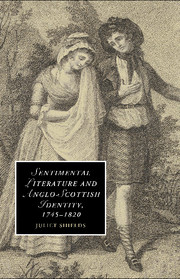Book contents
- Frontmatter
- Contents
- Acknowledgments
- Introduction: The politics and sentiments of union
- 1 The Ossian controversy and the racial beginnings of Britain
- 2 British masculinity and Scottish self-control
- 3 Sentimental correspondences and the boundaries of British identity
- 4 National tales and the domestication of the Scottish Highlands
- 5 Rebellions and re-unions in the historical novel
- Notes
- Bibliography
- Index
- CAMBRIDGE STUDIES IN ROMANTICISM
3 - Sentimental correspondences and the boundaries of British identity
Published online by Cambridge University Press: 06 August 2010
- Frontmatter
- Contents
- Acknowledgments
- Introduction: The politics and sentiments of union
- 1 The Ossian controversy and the racial beginnings of Britain
- 2 British masculinity and Scottish self-control
- 3 Sentimental correspondences and the boundaries of British identity
- 4 National tales and the domestication of the Scottish Highlands
- 5 Rebellions and re-unions in the historical novel
- Notes
- Bibliography
- Index
- CAMBRIDGE STUDIES IN ROMANTICISM
Summary
In the second half of the eighteenth century, novelists turned to epistolary narratives to explore the workings of sympathy and the formation of sentimental community because letters were considered a particularly genuine and intimate form of writing. The letter's generic claims to credibility, authenticity, and emotional intimacy are epitomized in Samuel Johnson's half-joking assertion in one of his own epistles to Hester Thrale that “in a Man's Letters … his soul lies naked, his letters are only the mirrour of his breast.” Epistolary fiction not only exploits the letter's generic connotations; it also formally embodies Smith's definition of sympathy in The Theory of Moral Sentiments as a “correspondence of sentiments” by assuming the existence of a recipient to whom the letter-writer bares his soul and from whom replies may be received. The epistolary novels that I will discuss in this chapter – Tobias Smollett's Expedition of Humphry Clinker (1771), Frances Burney's Evelina (1778), and Elizabeth Hamilton's Translations of the Letters of a Hindoo Rajah (1796) – explore the workings of sympathy through the exchange of letters that propels their plots. These novels imagine a Great Britain united by shared sentiments even while they illustrate the dangers that indiscriminate sympathy poses to national order and integrity. However, they are not simply imaginative narrativizations of Adam Smith's definition of sympathy. Instead, like The Theory of Moral Sentiments, they participated in eighteenth-century debates about who was worthy of sympathy and why.
- Type
- Chapter
- Information
- Publisher: Cambridge University PressPrint publication year: 2010



